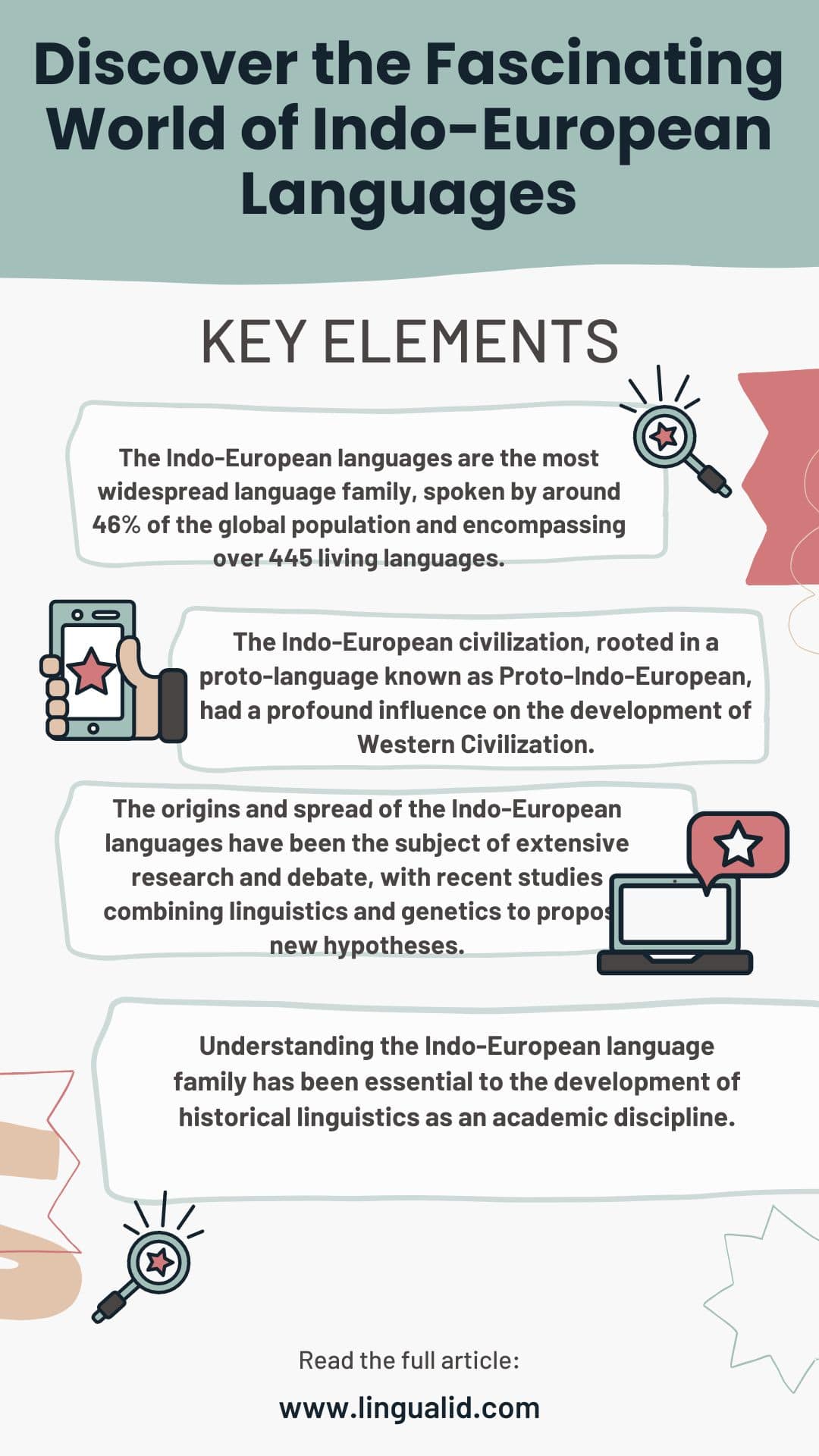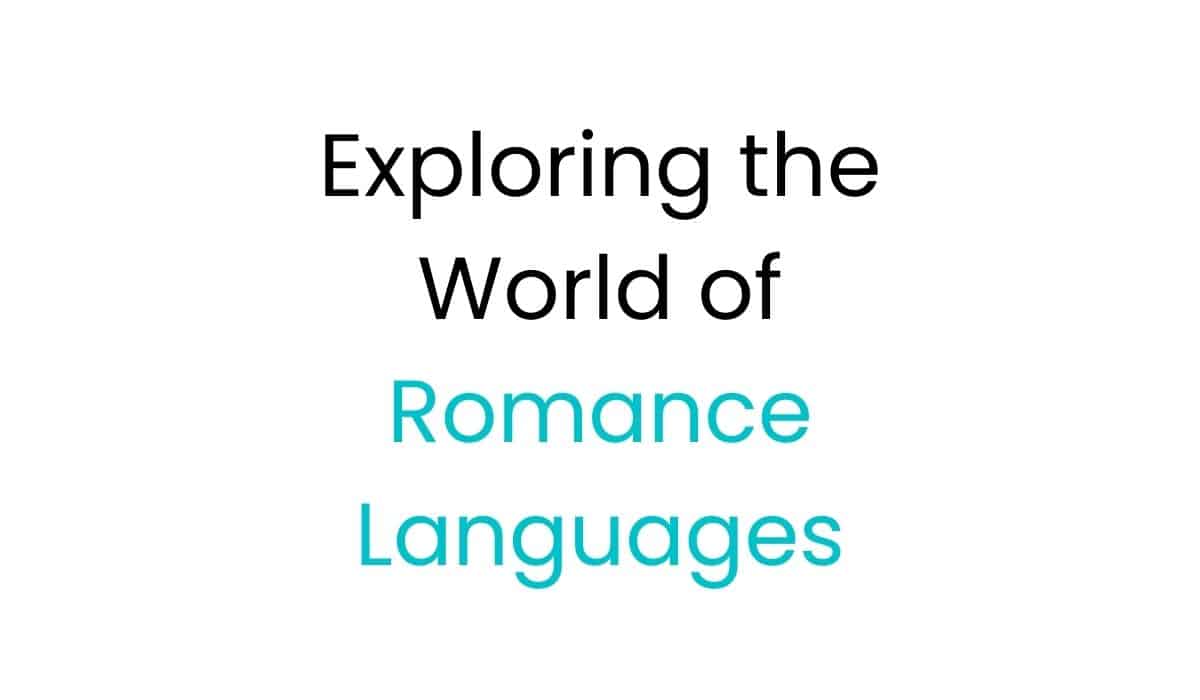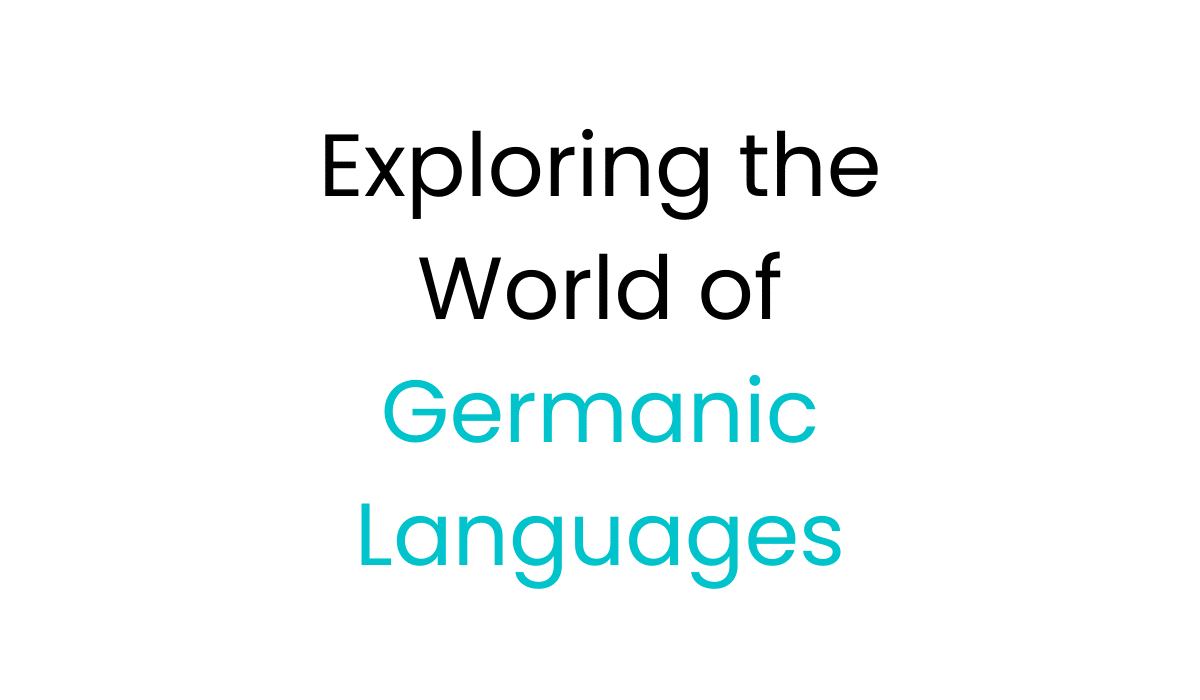Indo-European Languages: In the late 1700s, a British judge in India, William Jones, made a groundbreaking discovery. He noticed that many historical languages were similar. This led him to believe they came from the same source. This idea sparked a new field of study: historical linguistics.
Scholars have since worked to understand the “mother tongue” and its culture. They found that Indo-European languages are key to Western Civilization. Even though we don’t know much about the original Indo-Europeans, their legacy is huge. Their descendants now speak over half the world’s population.
Key Takeaways
- The discovery of the Indo-European language family dates back to the late 18th century when a British judge in India, William Jones, identified profound similarities between languages like Sanskrit, Latin, and Greek.
- The Indo-European languages are the most widespread language family, spoken by around 46% of the global population and encompassing over 445 living languages.
- The Indo-European civilization, rooted in a proto-language known as Proto-Indo-European, had a profound influence on the development of Western Civilization.
- The origins and spread of the Indo-European languages have been the subject of extensive research and debate, with recent studies combining linguistics and genetics to propose new hypotheses.
- Understanding the Indo-European language family has been essential to the development of historical linguistics as an academic discipline.
- Key Takeaways
- The Origins and Discovery
- The Significance of Historical Linguistics
- Language Branches and Distribution
- The Germanic Languages
- What is the discovery of the Indo-European languages?
- What is the significance of the Indo-European language family?
- What are the major branches of the Indo-European language family?
- How successful were the Indo-European expansions across Eurasia?
- How have linguistic studies of the Indo-European languages contributed to our understanding of the past?
- Where is the proposed homeland of the Proto-Indo-Europeans?
- How have the Indo-European languages impacted the world today?
Introduction to Indo-European Languages
The Origins and Discovery
William Jones, a British judge in India in the late 18th century, started the study of Indo-European languages. He noticed that Sanskrit, Latin, and Greek were very similar. This led to the study of historical linguistics, or how languages change over time.
Scholars later found the “mother tongue” of these languages, called Proto-Indo-European. They followed its spread and changes into the many languages we see today. This discovery shows that Indo-European cultures share a common history and origins across Eurasia.
The Significance of Historical Linguistics
Historical linguistics has been key in understanding the Indo-European languages. By looking at sound changes and grammar patterns, scholars have recreated the Proto-Indo-European language and its branches.
This research has given us insights into the ancient Indo-European people’s migrations, cultural exchanges, and social structures. It helps us see the shared history and connections between different civilizations, from India to Ireland. So, studying Indo-European languages is vital for understanding human history.
| Key Facts | Details |
|---|---|
| Pages | 240 |
| Illustrations | 1 |
| Publication Date | 04/01/1983 |
| Major Language Branches | 11 |
| Language Examples Cited | Old Irish, Sanskrit, Avestan, Latin, Osco-Umbrian |
| Bibliographies | Extensive |
| Geographical Distribution Map | Up-to-date |
| Family Tree Diagram | Detailed |
The Indo-European Language Family
The Indo-European language family is very widespread and important. It covers Europe, the Iranian plateau, and the Indian subcontinent. It includes about 445 living languages, which is over a third of the world’s population.
Language Branches and Distribution
The main branches of the Indo-European language family are Albanoid, Armenian, Balto-Slavic, Celtic, Germanic, Graeco-Phrygian, Indo-Iranian, and Italic. Two branches, Anatolian and Tocharian, are now extinct.
The Proto-Indo-European language started about 6,000 years ago in the Caucasus. It has led to a huge variety of languages today. The spread of Indo-European languages shows how Indo-European-speaking people moved across Eurasia.
| Branch | Major Languages | Approximate Date of Emergence |
|---|---|---|
| Albanoid | Albanian | c. 1st millennium BCE |
| Armenian | Armenian | c. late 2nd millennium BCE |
| Balto-Slavic | Russian, Polish, Lithuanian, Latvian | c. 1st millennium BCE |
| Celtic | Irish Gaelic, Welsh, Breton | c. 400 BCE |
| Germanic | English, German, Swedish, Dutch | c. 1st millennium BCE |
| Graeco-Phrygian | Greek | c. 3000 BCE |
| Indo-Iranian | Sanskrit, Avestan, Persian, Hindi, Bengali | c. 1300 BCE |
| Italic | Latin, Italian, Spanish, French | c. 6th century BCE |
| Anatolian (Extinct) | Hittite, Luwian, Palaic | c. 1800 BCE |
| Tocharian (Extinct) | Tocharian A, Tocharian B | c. 6th-8th century CE |
This table shows the main branches of the indo-european language family. It lists their languages and when they started. The Indo-European languages are very diverse and have had a big impact on history.
The Spread and Influence of Indo-European Languages
The Indo-Europeans were very successful in spreading across Eurasia. They often took over and replaced the people already living there. Starting in late prehistory, Indo-Europeans migrated in many directions. They became the main civilizations in many areas.
This includes the Indo-Aryans in India, the Persians in the Iranian plateau, the Greeks, Romans, Celts, and Vikings in Europe, and many others.
The spread of Indo-European languages was linked to the rise of these cultures. These cultures became dominant in much of the known world. Today, more than half the world speaks an Indo-European language.
Recent studies have given us new insights into the origins and migrations of the Indo-Europeans. A 2009 study found that the Proto-Indo-European language was spoken around 6,000 years ago in the Caucasus region. A 2010 study suggested that written language came about about 2,500 years later.
Genetic evidence has also been very helpful. In 2015, researchers found that DNA in the petrous bone of the inner ear can last for thousands of years. This lets them track the movements of ancient people. A 2018 study looked at the DNA of 727 individuals. It found that the Indo-European languages were likely spread by the Yamnaya group of horse-herding nomads from the Eurasian steppe.
As we keep studying the origins and spread of the Indo-European civilizations, scholars say we need more research. They suggest looking into the cultures of West Asia, the Caucasus, and the Eurasian steppe. Finding a ‘missing link’ could end the debate and help us understand the connection between the peoples of Asia and Europe better.
Indo-European Linguistics and Language Change
Linguistic research has given us a deep look into the origins and growth of the Indo-European language family. A key branch in this family is the Germanic languages. They came from a language called Common Germanic, which is a type of Proto-Indo-European.
The Germanic Languages
As people speaking Common Germanic moved and spread across northern Europe, the Germanic branch split into different groups. These include the Celtic, Germanic, and Scandinavian languages. This split led to unique sound changes and other features in the Germanic languages, like Grimm’s Law.
Studying these changes helps scholars understand the history and movements of ancient Germanic peoples. For example, they found that the Proto-Indo-European language started about 6,000 years ago, around the time of the wheel and axle invention. This means the original Proto-Indo-Europeans were likely herders of horses, cattle, and sheep.
Using methods like computational phylogenetics, we’ve learned more about how proto-indo-european, common Germanic, and Germanic languages like English, German, Dutch, and Yiddish changed and grew. This shows us the sound shifts and Grimm’s law that shaped the Scandinavian languages.
“The linguistic concept of computational phylogenetics is being used to analyze language evolution and derive evolutionary trees based on measurable traits.”
By studying the evolution of these proto-indo-european and Germanic languages, linguists have uncovered the migrations and cultural growth of ancient peoples. This has greatly expanded our knowledge of human history.
The Proto-Indo-European Language
The Indo-European languages cover Europe, South Asia, and Western Asia. They all come from a single ancient language called Proto-Indo-European. This language was likely spoken in the Neolithic or early Bronze Age. Most experts agree with the Kurgan hypothesis. This suggests the Proto-Indo-European homeland was in the Pontic-Caspian steppe region, linked to the Yamnaya culture.
Scholars have pieced together the Proto-Indo-European language through linguistic reconstruction. They found it had a detailed system of grammar, including inflectional suffixes and ablaut (changes in vowels). It also had a complex sound system, vocabulary, and copula.
Since we don’t have any writings from the original Proto-Indo-European people, linguists study their daughter languages. This helps them understand the language and culture of the Proto-Indo-European speakers. They’ve discovered many features of their language.
- About 15 stop consonants, sorted by where they’re made and how the vocal cords move
- Probably just one sibilant consonant, ‘s,’ with a voiced version ‘z’
- A vowel system with certain sounds based on tongue position and height
- Ablaut, a pattern of vowel changes
- An accent system that uses pitch, with one stressed syllable per word
The comparative method in linguistics has been key in showing the Indo-European languages are related. Scholars like William Jones and Jacob Grimm have greatly helped in this area.
| Key Dates and Events | Significance |
|---|---|
| 1786: William Jones suggests the common ancestry of Sanskrit, Greek, Latin, Gothic, Celtic languages, and Old Persian | Initiates the study of the Indo-European language family |
| 1822: Jacob Grimm formulates Grimm’s law, showing correlations between Germanic and other Indo-European languages | Demonstrates systematic sound change in language evolution |
| 1870s: The Neogrammarians propose that sound laws have no exceptions | Illustrates language evolution rules |
Reconstructing the Proto-Indo-European language has given us deep insights into the culture and language history of Indo-European-speaking peoples. It has helped us understand their past and how their languages evolved.
Indo-European Languages in Mythology and Culture
The spread of proto-indo-european culture has led to a big effort to learn about the society and mythology of the original Proto-Indo-European speakers. Since we don’t have direct records, scholars look at the languages and cultures of their descendants. They study the Hittites, the Vedas of India, and the mythologies of ancient Greece and Rome.
The Indo-European Migrations
The spread of Indo-European-speaking peoples across Eurasia was complex and often tumultuous. It involved waves of migrations and invasions that changed the social and political scenes of many regions. This started in late prehistory and went through the Bronze Age and Iron Age. Indo-European groups like the Indo-Aryans, Persians, Hittites, Greeks, Romans, Celts, Vikings, and Philistines moved from their origins. They displaced or conquered many indigenous populations.
This Indo-European expansion was often marked by upheaval and social change. It even led to the extermination of entire cultures. The historical record shows how successful the Indo-Europeans were in becoming the dominant civilizations in Europe and Western Asia.
| Timeline | Event |
|---|---|
| 4000 – 1000 BCE | The Indo-European migrations took place |
| Around 3000 BCE | Late Proto-Indo-European was spoken within the Yamnaya horizon on the Pontic-Caspian steppe |
| 2100 – 1800 BCE | The Proto-Indo-Iranian language and culture likely emerged within the Sintashta culture |
| 5000 BCE | Horses were domesticated by the Yamnaya people, enhancing their ability to travel and settle in new territories |
Genetic research has found that Indo-European men share a Y-DNA haplogroup called R1a. This haplogroup is found in Western Europe, Ukraine, southern Russia, Uzbekistan, Iran, and among the priestly caste in India. The Kurgan hypothesis was backed by genetic research. This confirms the common origin of Indo-European people groups from the Yamnaya culture.
Indo-European languages
The Indo-European language family is a vast collection of languages, with about 445 living languages and over 3.2 billion people speaking them. This is almost half of the world’s population. These languages have greatly influenced the way people communicate across Eurasia and beyond.
English, Spanish, Portuguese, Russian, and many others are part of this family. Each has more than 100 million native speakers. This shows how Indo-European languages spread and shaped cultures over time.
This family is split into branches like Albanoid, Armenian, and Germanic. Each branch reflects the language’s wide spread across Eurasia. These languages have evolved through migration and cultural exchange, creating a rich heritage.
| Indo-European Language Branch | Notable Languages | Approximate Number of Native Speakers |
|---|---|---|
| Indo-Iranian | Hindi, Urdu, Bengali, Punjabi, Persian | 1.5 billion |
| Slavic | Russian, Polish, Ukrainian, Serbo-Croatian | 300 million |
| Romance | Spanish, Portuguese, French, Italian, Romanian | 800 million |
| Germanic | English, German, Dutch, Swedish, Norwegian | 500 million |
| Hellenic | Greek | 13 million |
The Indo-European language family shows the vast diversity and strength of human language. By studying these languages, we learn about the rich cultures and history of the people who have shaped our world.
The Impacts and Legacies of Indo-European Languages
The indo-european impact and indo-european legacy have deeply shaped human history. These languages spread with the expansion of Indo-European-speaking peoples. They conquered and merged with many cultures in Europe, Asia, and beyond. This has greatly influenced the world’s languages and cultures.
Now, half the global population speaks an Indo-European language at home. This shows the historical significance and lasting impact of this language family. Studying Indo-European languages has helped us understand history and culture.
- The study of linguistics began to gain momentum in the late 18th century.
- Around 3,000 BC, the Indo-Europeans started dispersing in waves of migration.
- The Indo-European family of languages consists of two main divisions: Western and Eastern.
- The Western division of Indo-European comprises four subfamilies: Hellenic, Italic, Germanic, and Celtic.
- English is categorized as a Germanic language within the Western division of Indo-European.
The indo-european impact is seen in the many borrowed words and influences over time. Languages in the Western Indo-European family have borrowed words from Latin, French, Spanish, and Italian. This shows the loan-words that have entered English and other languages.
“Almost three billion humans today speak languages belonging to the Indo-European family.”
The indo-european legacy shows the deep and lasting effect of this language family on human culture and history. Indo-European linguistics continues to give us insights into our shared past and how languages have evolved.

Conclusion
The study of the Indo-European language family has changed how we see history. It shows us how different cultures are connected through language. From William Jones’ early work to modern reconstructions, we’ve learned a lot about our past.
These languages are now spoken by billions worldwide. They show the lasting impact of the Indo-European people. Their languages have shaped many cultures and societies.
Studying Indo-European languages helps us understand Eurasia’s history. It tells us about the people who moved and interacted with each other. This gives us a clearer picture of our shared human story.
Indo-European languages are fascinating to scholars and fans. Research into them keeps giving us new insights. As we learn more, we see how language ties us together across time and space.
FAQ
What is the discovery of the Indo-European languages?
In the late 18th century, a British judge named William Jones made a groundbreaking find. He was living in India and noticed many languages shared similarities. This led to the study of historical linguistics and how languages change over time.
What is the significance of the Indo-European language family?
Finding the Indo-European languages showed that many cultures share a common origin. Scholars found the “mother tongue” of these languages, called Proto-Indo-European. They tracked how it spread and changed into the many languages we see today.
What are the major branches of the Indo-European language family?
The Indo-European languages have many branches, like Albanoid and Germanic. Some branches, like Anatolian, are extinct. Today, there are about 445 living Indo-European languages, with the Indo-Iranian branch being the largest.
How successful were the Indo-European expansions across Eurasia?
Indo-Europeans were very successful in spreading across Eurasia. They moved in many directions, becoming the main civilizations in many places. They include the Indo-Aryans in India, the Persians in the Iranian plateau, and the Greeks and Romans in Europe.
How have linguistic studies of the Indo-European languages contributed to our understanding of the past?
Linguistic studies have given us deep insights into the Indo-European languages. By looking at how these languages changed, scholars can trace the history and movements of the ancient Indo-European peoples. They also help us understand their culture and religion.
Where is the proposed homeland of the Proto-Indo-Europeans?
Most scholars believe the Proto-Indo-Europeans came from the Pontic-Caspian steppe. This area is linked to the Yamnaya culture. They likely spoke their ancestral language during the Neolithic or early Bronze Age.
How have the Indo-European languages impacted the world today?
Indo-European languages are the most common, with about 445 living languages and over 3.2 billion speakers. This shows the wide spread of Indo-European-speaking civilizations and cultures. They have greatly influenced the world’s languages, cultures, and politics.
Oualid Cheddadi is the founder of Lingualid, a platform that inspires independent language learners worldwide, regardless of the language they are learning. The name “Lingualid” is derived from the Portuguese word for “language,” “língua,” and the last three letters of Oualid’s name, “Lid.”



